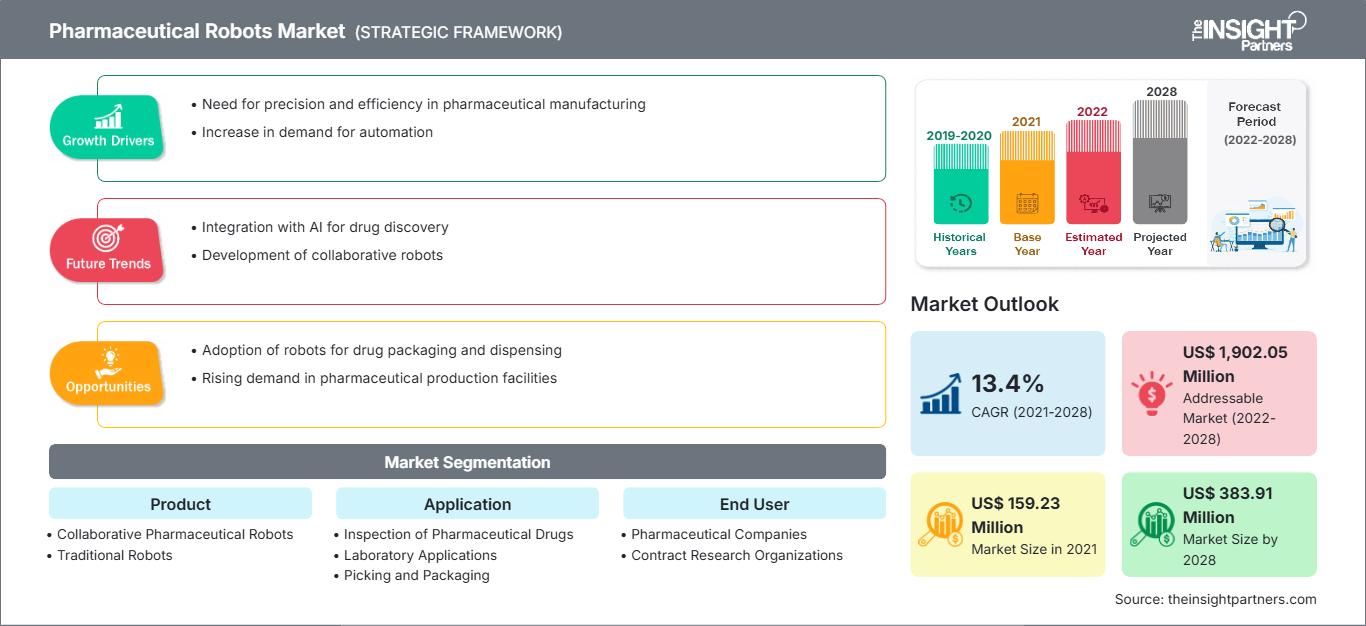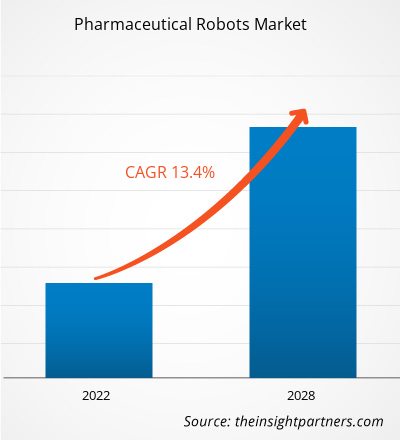[Rapporto di ricerca] Si prevede che il mercato dei robot farmaceutici raggiungerà i 383,91 milioni di dollari entro il 2028, rispetto ai 159,23 milioni di dollari del 2021; si prevede una crescita a un CAGR del 13,4% dal 2021 al 2028.
L'industria farmaceutica richiede efficienza e precisione nella produzione di farmaci. Pertanto, l'utilizzo di robot nella produzione farmaceutica migliora la qualità e riduce costi e tempi. I robot si stanno dimostrando vantaggiosi nel riempimento, nell'ispezione, nel confezionamento, nei laboratori e nella produzione di medicinali personalizzati. Un sistema robotico è un tipo di automazione che ha più assi di movimento e può essere programmato per svolgere qualsiasi funzione.
Il rapporto offre approfondimenti e analisi approfondite del mercato dei robot farmaceutici, sottolineando vari parametri come tendenze di mercato, progressi tecnologici, dinamiche di mercato e analisi del panorama competitivo dei principali attori del mercato in tutto il mondo. Include anche l'impatto della pandemia di COVID-19 sul mercato in tutte le regioni. L'impatto della pandemia e la riduzione delle attività di ricerca a livello globale hanno inoltre danneggiato le operazioni e la gestione finanziaria di diverse aziende operanti nel mercato dei robot farmaceutici. L'OIE, l'Organizzazione Mondiale per la Salute Animale, sostiene la ricerca per le sue ricerche in corso e per le altre implicazioni del COVID-19 sulla salute animale e sulla salute pubblica del pollame. L'organizzazione contribuisce anche alla valutazione, alla gestione e alla comunicazione del rischio. L'OIE ha implementato un sistema di coordinamento degli incidenti per coordinare queste attività. Inoltre, la pandemia di COVID-19 e le conseguenti imposizioni di lockdown hanno avuto un impatto significativo sui settori dell'allevamento e del pollame in diversi paesi del mondo. Si è riscontrato che il divario tra domanda e offerta si sta gradualmente riducendo con l'apertura delle catene di mercato e le ulteriori misure adottate dalle amministrazioni locali per colmare i colli di bottiglia nei sistemi di distribuzione. Si prevede inoltre che l'impatto continuerà a essere duraturo e avrà un impatto significativo sui mezzi di sussistenza, sull'occupazione e sull'economia complessiva del settore. Il mercato dei robot farmaceutici è segmentato in base a dosaggio, patologia, tecnologia e regione. Il mercato, in base alla regione, è segmentato in Nord America, Europa, Asia Pacifico, Medio Oriente e Africa e Sud e Centro America.
Approfondimenti di mercato
Personalizza questo rapporto in base alle tue esigenze
Potrai personalizzare gratuitamente qualsiasi rapporto, comprese parti di questo rapporto, o analisi a livello di paese, pacchetto dati Excel, oltre a usufruire di grandi offerte e sconti per start-up e università
Mercato dei robot farmaceutici: Approfondimenti strategici

-
Ottieni le principali tendenze chiave del mercato di questo rapporto.Questo campione GRATUITO includerà l'analisi dei dati, che vanno dalle tendenze di mercato alle stime e alle previsioni.
La robotica basata sul cloud è un campo emergente della robotica che affonda le sue radici nel cloud computing, nell'archiviazione cloud e in altre tecnologie Internet, incentrate sui vantaggi dell'infrastruttura convergente e dei servizi condivisi. La connessione dei robot al cloud aumenta la potenza di calcolo, l'archiviazione e le comunicazioni. I robot basati sul cloud comunicano tra loro, semplificando così l'esecuzione delle operazioni.
La piattaforma Google Cloud Robotics combina intelligenza artificiale, robotica e cloud per consentire l'apertura di un ecosistema di soluzioni di automazione che utilizzano robot collaborativi connessi al cloud. Insieme ai servizi di intelligenza artificiale e apprendimento automatico, i robot saranno in grado di eseguire in modo efficiente i processi in ambienti altamente dinamici nell'industria manifatturiera. Inoltre, in questo settore, il cloud è un alleato per l'elaborazione di grandi quantità di dati. Ad esempio, Exscientia e Celgene, un'azienda biofarmaceutica, hanno annunciato un accordo da 19,64 milioni di euro nel 2019 per accelerare la scoperta di farmaci contro il cancro e le malattie autoimmuni. Nel 2020, ha anche annunciato una collaborazione con altre aziende per trovare possibili farmaci contro il COVID-19. Di conseguenza, l'azienda ha ora accesso a un pacchetto di molecole, inclusi farmaci e altre sostanze chimiche, che sono state testate con successo sugli esseri umani. L'azienda intendeva esaminare l'elenco alla ricerca di farmaci in grado di combattere il virus. La tecnologia di Exscientia analizza i grandi database ed è in grado di prevedere con precisione quali composti non generano effetti collaterali per raggiungere l'obiettivo desiderato. Analogamente, nel 2020, un'altra azienda farmaceutica, Boehringer Ingelheim, ha stretto una partnership con un'azienda biotecnologica, Click Therapeutics, per produrre 500 milioni di dollari in trattamenti digitali. Più precisamente, entrambe le aziende prevedevano di collaborare allo sviluppo e alla distribuzione di un'applicazione mobile per aiutare i pazienti schizofrenici con deficit cognitivi. Inoltre, IBM ha creato RoboRXN, un laboratorio chimico che utilizza l'intelligenza artificiale, il cloud computing e la robotica per sviluppare farmaci direttamente dalle case dei ricercatori.
Un software basato su cloud, con protocolli di sicurezza appropriati, può essere adottato per facilitare l'integrazione e l'automazione. Il suo utilizzo contribuisce a ridurre la burocrazia delle aziende, rendendo i dati gestibili. Pertanto, si prevede che la robotica cloud diventerà la tendenza futura nel mercato dei robot farmaceutici.
Approfondimenti basati sul prodotto
In base al prodotto, il mercato dei robot farmaceutici è segmentato in robot farmaceutici collaborativi e robot tradizionali. Si stima che nel 2021, il segmento dei robot farmaceutici collaborativi rappresenterà la quota di mercato maggiore, mentre si prevede che i robot tradizionali registreranno il CAGR più elevato sul mercato durante il periodo di previsione. La crescita di questo segmento è attribuita all'aumento dell'utilizzo di robot nella dispensazione, nello smistamento, nell'assemblaggio di kit e nella manutenzione di macchinari leggeri, nonché in applicazioni più tradizionali associate al confezionamento e ad altri.
Approfondimenti basati sull'applicazione
In base all'applicazione, il mercato dei robot farmaceutici è segmentato in ispezione di farmaci, applicazioni di laboratorio e prelievo e confezionamento. Il segmento dell'ispezione dei farmaci detiene la quota maggiore del mercato nel 2021 e si stima che registrerà il CAGR più elevato del mercato durante il periodo di previsione.
Approfondimenti basati sull'utente finale
In base all'utente finale, il mercato dei robot farmaceutici è segmentato in aziende farmaceutiche, laboratori di ricerca e organizzazioni di ricerca a contratto. Il segmento delle aziende farmaceutiche detiene la quota maggiore del mercato nel 2021, mentre si stima che il segmento dei laboratori di ricerca registrerà il CAGR più elevato del mercato durante il periodo di previsione.
Gli operatori del mercato dei robot farmaceutici adottano strategie organiche come il lancio e l'espansione dei prodotti per espandere la propria presenza e il portafoglio prodotti a livello mondiale, nonché per soddisfare la crescente domanda.
Approfondimenti regionali sul mercato dei robot farmaceutici
Le tendenze regionali e i fattori che influenzano il mercato dei robot farmaceutici durante il periodo di previsione sono stati ampiamente spiegati dagli analisti di The Insight Partners. Questa sezione analizza anche i segmenti e la geografia del mercato dei robot farmaceutici in Nord America, Europa, Asia-Pacifico, Medio Oriente e Africa, America meridionale e centrale.
Ambito del rapporto sul mercato dei robot farmaceutici
| Attributo del rapporto | Dettagli |
|---|---|
| Dimensioni del mercato in 2021 | US$ 159.23 Million |
| Dimensioni del mercato per 2028 | US$ 383.91 Million |
| CAGR globale (2021 - 2028) | 13.4% |
| Dati storici | 2019-2020 |
| Periodo di previsione | 2022-2028 |
| Segmenti coperti |
By Prodotto
|
| Regioni e paesi coperti |
Nord America
|
| Leader di mercato e profili aziendali chiave |
|
Densità degli attori del mercato dei robot farmaceutici: comprendere il suo impatto sulle dinamiche aziendali
Il mercato dei robot farmaceutici è in rapida crescita, trainato dalla crescente domanda degli utenti finali, dovuta a fattori quali l'evoluzione delle preferenze dei consumatori, i progressi tecnologici e una maggiore consapevolezza dei benefici del prodotto. Con l'aumento della domanda, le aziende stanno ampliando la propria offerta, innovando per soddisfare le esigenze dei consumatori e sfruttando le tendenze emergenti, alimentando ulteriormente la crescita del mercato.

- Ottieni il Mercato dei robot farmaceutici Panoramica dei principali attori chiave
- Robot farmaceutici collaborativi
- Robot tradizionali
- Robot Delta
- Robot articolati
- Robot cartesiani
- Robot SCARA
- Altri
Per applicazione
- Ispezione di farmaci
- Applicazioni di laboratorio
- Prelievo e confezionamento
Per utente finale
- Aziende farmaceutiche
- Laboratori di ricerca
- Organizzazioni di ricerca a contratto
Per
Geografia
-
Nord America
- Stati Uniti
- Canada
- Messico
-
Europa
- Francia
- Germania
- Italia
- Regno Unito
- Spagna
- Resto d'Europa
-
Asia Pacifico (APAC)
- Cina
- India
- Corea del Sud
- Giappone
- Australia
- Resto dell'APAC
-
Medio Oriente e Africa (MEA)
- Sudafrica
- Arabia Saudita
- Emirati Arabi Uniti
- Resto del MEA
-
America del Sud e Centro (SCAM)
- Brasile
- Argentina
- Resto del SCAM
Profili aziendali
- ABB Ltd.
- Kawasaki Heavy Industries, Ltd.
- Yaskawa Electric Corporation
- Universal Robots A/S
- Marchesini Group SpA
- Denso Corporation
- Fanuc Corporation
- Espon India Pvt. Ltd.
- Shibuya Corporation
- Weiss GmbH
- Analisi storica (2 anni), anno base, previsione (7 anni) con CAGR
- Analisi PEST e SWOT
- Valore/volume delle dimensioni del mercato - Globale, Regionale, Nazionale
- Industria e panorama competitivo
- Set di dati Excel
Report recenti
Rapporti correlati
Testimonianze
Motivo dell'acquisto
- Processo decisionale informato
- Comprensione delle dinamiche di mercato
- Analisi competitiva
- Analisi dei clienti
- Previsioni di mercato
- Mitigazione del rischio
- Pianificazione strategica
- Giustificazione degli investimenti
- Identificazione dei mercati emergenti
- Miglioramento delle strategie di marketing
- Aumento dell'efficienza operativa
- Allineamento alle tendenze normative






















 Ottieni un campione gratuito per - Mercato dei robot farmaceutici
Ottieni un campione gratuito per - Mercato dei robot farmaceutici